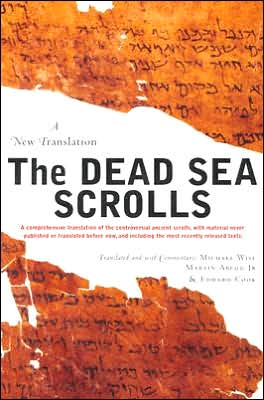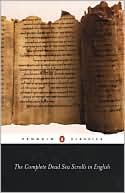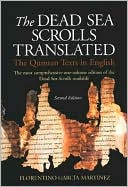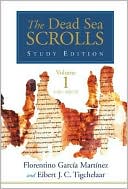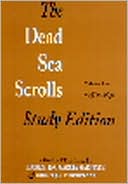Dead Sea Scrolls: A New Translation
A fully revised and updated edition of our translation of the complete Dead Sea Scrolls, making it the definitive translation of the Scrolls in English.\ With new texts, updated introductions, a glossary of terms, and other new additions, this will become the definitive translation of the Scrolls, and the lead companion to our other Dead Sea Scrolls Guides: The Meaning of the Dead Sea Scrolls and the Dead Sea Scrolls Bible.
Search in google:
This revision of the 1996 edition marks the golden anniversary of the discovery of the Dead Sea Scrolls, of major significance to understanding early Judaism and Christianity. Incorporating newly available scholarship, Wise (Hebrew Bible, Northwestern College, St. Paul, Minnesota) presents annotated English translations of the Enoch, Qumran calendar, and other key texts. The introduction enlightens general readers on the controversial reconstruction and interpretation process and technological aids. Annotation ©2006 Book News, Inc., Portland, OR John Dominic Crossan The Dead Sea Scrolls are not just for scholars anymore. They are here in a book that anyone can understand. Read these texts. Hidden in their caves, they survived the ravages of time and decay to speak to us today across two thousand years. They have survived their authors and will survive us, their readers.
The Dead Sea Scrolls - Revised Edition\ A New Translation \ \ By Michael Wise \ HarperCollins Publishers, Inc.\ Copyright © 2005 Michael Wise\ All right reserved.\ ISBN: 006076662X \ \ \ \ Chapter One\ \ \ Reading a Dead Sea Scroll\ \ In order to read a Dead Sea Scroll with proper appreciation and a modicum of critical acumen, it's important to know what you are reading. That may seem trite, but it's true. How does one go from a hugger-mugger of over 15,000 tiny scraps of skin and ink to about 900 full-blown manuscripts, and from there to published texts and translations? You should have some idea of the various steps involved in the process. Only then can you begin to think for yourself about what you will be reading in the following pages. Understanding the process by which the scrolls have been put together will help you to avoid the reader's cardinal sin -- trusting an author too much. If we have certain ideas to present, we want you to be persuaded, not simply take our word for it. We want you to know just how much reconstructing the scrolls can be a matter of judgment (possibly mistaken) and uncertainty. We also want you to be able to make sense of the various sigla, brackets, and other paraphernalia that decorate the translations in this book.\ As noted in the Introduction, the first seven Dead Sea Scrolls were discovered more or less intact. That can be said of very few of the hundreds of works that came to light subsequently. The early members of the scrolls editorial team found themselves facing an enormously complex jigsaw puzzle. After a short time, they worked out a modus operandi. Thousands of fragments were spread out on the tables of the Palestine Archaeological Museum, flattened under glass. The editors would walk from table to table, scrutinizing the fragments and trying to match them with this or that grouping they had already isolated. One of the editors, John Allegro, has described the guiding principle of those early efforts:\ \ One of the saving factors has been that of the four hundred [later, eight hundred] or so manuscripts we have had to deal with, surprisingly few were written by the same scribe, so that by recognizing the idiosyncrasies of one's own scribes one could be fairly sure that the piece belonged to his document.\ \ Handwriting was thus the foremost criterion that the editors used to separate fragments into piles and then into manuscripts. A second important guide was the skin on which the texts were inscribed. The treated hides of goats, ibex, and even gazelle used for the scrolls are not uniform in thickness or color. Each skin is, so to speak, its own animal: one might be thick, another thin; one might have a reddish cast, another could be nearly black. Study of the differences in the skins was therefore important for figuring out how to group fragments. But the skins could sometimes be misleading. Though they might have been uniform shortly after they were first placed in the caves, when they came out of the caves as manuscript fragments, they could differ markedly in appearance. The reason: the variable conditions in which they had spent the past two millennia. Some fragments were exposed to more light than others, some to more moisture or a different soil chemistry. Still, in general, handwriting and the appearance of the skins were reasonably trustworthy as dual criteria guiding the early work of separating out scrolls. For the hundred or so texts written not on skin, but on papyrus, scrutiny of the patterns of the plant fibers in the papyrus helped in the separating.\ Work on proper identification of the fragments continues to this day. Although the early editors did their work of sorting admirably well, they were not infallible. Sometimes they made mistakes; in fact, we suggest a few that we think we've caught in the pages that follow (for example, see Assorted Manuscripts, text 121). Scholars continue to assess older conclusions. Advancing technology holds the promise of new approaches, although, since in most cases there is little doubt about the sorting, help will come mostly "at the margins." In this vein, researchers at Brigham Young University have recently begun to extract DNA from some of the fragments. Extraction does minimal damage to the materials, and DNA analysis makes it possible to identify the individual animal from which each fragment came. Where there is some question about a given fragment, or where fragments have never been assigned to any manuscript (there is a fairly sizable group of such pieces, all extremely tiny), this new approach may accomplish a modest breakthrough.\ Once the early editors had grouped the fragments of a given manuscript together on one or more plates, they had photographs taken. Also, each manuscript was assigned a "Q-number," indicating which cave it had come from. For example, 4Q242 means Cave 4 of Q(umran), the 242nd manuscript from that cave. (This system did not yet exist when the first seven scrolls were discovered, so they have no number. They are designated by abbreviations of their names; e.g., 1QS means: Cave 1 of Q(umran), Serek [Hebrew for "order"].) As work progressed and new fragments were identified, or it became clear that questionable assignments were in fact mistaken and fragments were removed, the shape of a given manuscript changed, and new photographs were taken. Today we can study the entire sequence of photographs for each manuscript. For the most part, these photographs were taken under infrared light. Time had so blackened many of the fragments that the writing on them was nearly invisible to the naked eye. Infrared photography rendered the invisible visible. The use of infrared explains why you seldom see color photographs of the more fragmentary manuscripts; in the 1950s, color infrared photography was not yet possible (now it is).\ Because these photographs were usually so much more legible than the manuscripts themselves, the early editors worked mostly with the photographs, and subsequent scholars have continued this practice. Autopsy of the original manuscript is still important, for it can resolve uncertainties (is this odd mark ink or just a spot on the skin?), but research on . . .\ \ Continues...\ \ \ \ Excerpted from The Dead Sea Scrolls - Revised Edition by Michael Wise Copyright © 2005 by Michael Wise.\ Excerpted by permission.\ All rights reserved. No part of this excerpt may be reproduced or reprinted without permission in writing from the publisher.\ Excerpts are provided by Dial-A-Book Inc. solely for the personal use of visitors to this web site. \ \
\ Bible Review...[T]he spirit of debate and critique, reappraisal and revision is here very much present. The brief discussions of the languages and scripts of the scrolls are a nice and somewhat unusual touch in a volume of this kind.\ \ \ \ \ Journal of Biblical Literature...[A] rather readable presentation of a large portion of the non-biblical scrolls, which commends itself to the general reader.\ \ \ Bible Review...the spirit of debate and critique, reappraisal and revision is here very much present. The brief discussions of the languages and scripts of the scrolls are a nice and somewhat unusual touch in a volume of this kind.\ \ \ \ \ Journal of Biblical Literature...a rather readable presentation of a large portion of the non-biblical scrolls, which commends itself to the general reader.\ \ \ \ \ John Dominic CrossanThe Dead Sea Scrolls are not just for scholars anymore. They are here in a book that anyone can understand. Read these texts. Hidden in their caves, they survived the ravages of time and decay to speak to us today across two thousand years. They have survived their authors and will survive us, their readers.\ \ \ \ \ Bible Review...[T]he spirit of debate and critique, reappraisal and revision is here very much present. The brief discussions of the languages and scripts of the scrolls are a nice and somewhat unusual touch in a volume of this kind.\ \ \ \ \ Journal of Biblical Literature...[A] rather readable presentation of a large portion of the non-biblical scrolls, which commends itself to the general reader.\ \
